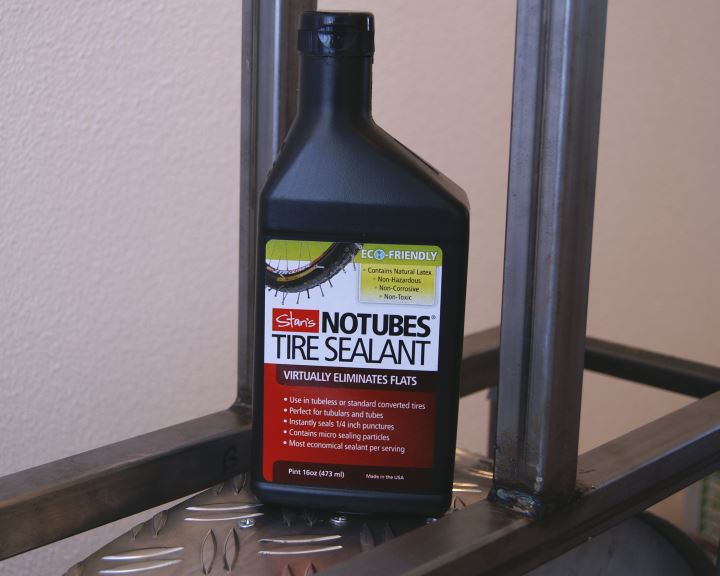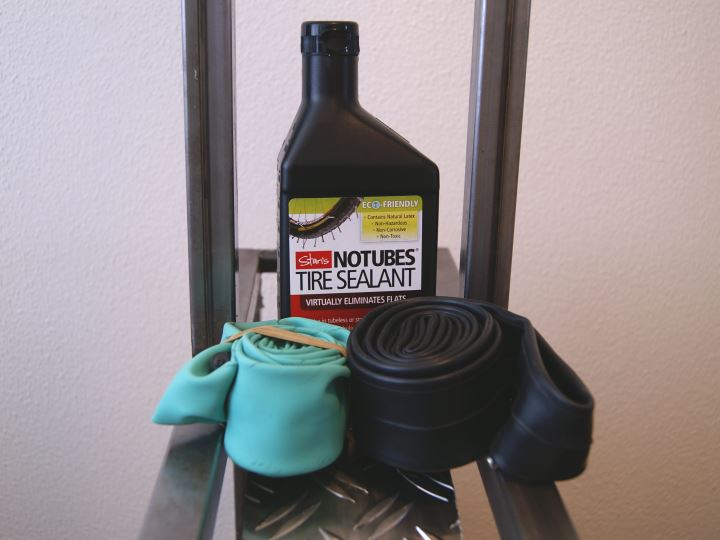Tubeless vs Latex Tube vs Butyl Tube, Rolling Resistance Compared

How much faster is a tubeless mountain bike tire compared to the same tire fitted with a butyl inner tube? Do latex inner tubes have less rolling resistance? And exactly how much lower is the rolling resistance of a mountain bike tire at different air pressures? These frequently asked questions deserve an answer. In this article, I will present all data collected from tests done with a tubeless converted tire and latex and butyl inner tubes.
Ad Buy Tubeless Kits at Amazon.com
For this comparison article, I've used a Continental Race King RaceSport 29 x 2.2 mountain bike tire. This is the exact same tire I've reviewed previously, for all specifications, you can read it's review here. In this special article, I ran tests at an even lower air pressure of 15 psi / 1.0 bar. The regular reviews only go down to 25 psi / 1.7 bars.
Test set up
All tests are performed with the same wheel, tire, load, and speed. With the only difference being a tubeless set up, a latex inner tube or a butyl inner tube. Measurements are taken at air pressures of 15, 25, 35, 45 and 55 psi.
Test conditions
- Speed of 18 mph / 29 km/h
- Total wheel load of 94 lbs/ 42.5 kg
- Temperature between 21-23 °C / 70-73 °F
- Rolling Resistance Test Conditions Explained
Butyl inner tube set up
- Brand: Continental
- Model: Std Butyl 29 x 1.75 - 2.50"
- Weight: 225 grams
Latex inner tube set up
- Brand: Michelin
- Model: Aircomp A4
- Weight: 140 grams
Tubeless set up
- Sealant: 60 ml Stans Notubes
- Rim Strip: Notubes Rim Strip
- Weight: Strip + Sealant = 125 grams
Test Results
Total weight
There is a weight advantage for the tubeless set up and latex tube. I only used 60 ml of sealant which was enough for running on the test bench; you might need a bit more when going off-road. I would say tubeless, and latex are about equal in the weight department. It did take three days to get the Race King to seal completely; it was leaking through the sidewalls quite a bit. You have to take your time for the tubeless set up of Continental RaceSport tires.
Rolling Resistance
| Tubeless | Latex Tube | Butyl Tube | |
|---|---|---|---|
| Total Wheel Weight | 1600 grams | 1615 grams | 1700 grams |
| Rolling Resistance 55 psi / 3.8 Bar | 15.5 Watts | 15.6 Watts | 18.0 Watts |
| Rolling Resistance 45 psi / 3.1 Bar | 15.8 Watts | 16.0 Watts | 18.7 Watts |
| Rolling Resistance 35 psi / 2.4 Bar | 16.2 Watts | 16.9 Watts | 20.0 Watts |
| Rolling Resistance 25 psi / 1.7 Bar | 17.4 Watts | 18.5 Watts | 22.4 Watts |
| Rolling Resistance 15 psi / 1.0 Bar | 20.2 Watts | 22.0 Watts | 27.9 Watts |
| Rolling Resistance Coefficient (Crr) 55 psi / 3.7 Bar | 0.0046 | 0.0046 | 0.0054 |
| Rolling Resistance Coefficient (Crr) 45 psi / 3,1 Bar | 0.0047 | 0.0048 | 0.0056 |
| Rolling Resistance Coefficient (Crr) 35 psi / 2,4 Bar | 0.0049 | 0.0051 | 0.0060 |
| Rolling Resistance Coefficient (Crr) 25 psi / 1,7 Bar | 0.0052 | 0.0055 | 0.0067 |
| Rolling Resistance Coefficient (Crr) 15 psi / 1.0 Bar | 0.0061 | 0.0066 | 0.0084 |
The line chart says it all! It's very clear that tubeless mountain bike tires and latex inner tubes have less rolling resistance at the same tire pressure when compared to a butyl inner tube. It's also very clear that the difference gets bigger at lower air pressures. I'm surprised by the performance of the latex inner tube, at 55 psi / 3.8 bars the difference is almost zero when compared to the tubeless set up. Dropping pressure to 15 psi / 1.0 bars results in a 1.8 watts disadvantage for the latex inner tube.
When we compare the tubeless set up to the butyl inner tube, the difference is significant, at 55 psi / 3.8 bars you're already losing 2.5 watts per tire. Lowering the air pressure to 15 psi / 1.0 bars results in a 7.7 watts per tire advantage for the tubeless set up. That's more than 15 watts of additional rolling resistance for a pair of tires!
Conclusion

I hope I've been able to answer a lot of questions with this comparison. It's pretty clear that when you want to get the most out of your mountain bike tires, you will have to convert them to tubeless. Switching your tires from butyl inner tubes to a tubeless set up with sealant will lower rolling resistance by 10 - 15 watts depending on air pressure! If you don't want to go tubeless, consider the latex inner tubes which will save you 8 - 12 watts for a pair of mountain bike tires when compared to butyl tubes.
Do consider that latex tubes (and tubeless tires that do not seal that well) have the disadvantage of not holding air as long as butyl tubes. With latex tubes and tubeless tires, you'll have to check the air pressure every ride.
- Tubeless tires have the least rolling resistance
- Tubeless tires are the hardest to set up
- Latex inner tubes come close to the tubeless set up
- Latex inner tubes have to be pumped every day
- Butyl inner tubes have much higher rolling resistance
- Butyl inner tubes are low maintenance
What about ultra-light butyl tubes?
Some brands also sell ultra-light butyl mountain bike tubes, which have a weight of about 150-160 grams for the 29-inch version. My estimate is that the rolling resistance of these tubes falls somewhere in between the latex tube and the 225 grams butyl tube. This is based on tests of different road bike inner tubes which you can read here: Road bike inner tube comparison
Do you want to convert to Tubeless?
I was skeptical about tubeless wheels before converting my standard wheels to tubeless. After using it for a while and doing these tests, I'm a big fan of tubeless systems now. Converting my wheels was way easier than I expected it would be. If you have standard rims as well, I recommend just grabbing a mountain bike tubeless kit. The tubeless kit comes with everything you need for 2 wheels (rim strip or tape, valves, valve tool, sealant).
Ad Buy Tubeless Kits at Amazon.com
